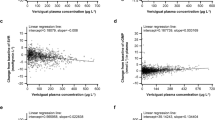Abstract
Purpose
Single- and multiple-dose studies were conducted to assess the pharmacokinetics, pharmacodynamics and safety of tolvaptan in healthy Japanese subjects.
Methods
All studies were single-center, randomized, placebo-controlled, single-blind or double-blind. In an ascending single-dose study, subjects were given a single oral dose of 15–120 mg tolvaptan or placebo. In multiple-dose studies, subjects were given 30, 60, 90 or 120 mg tolvaptan or placebo once daily for 7 days.
Results
After a single dose of 15–120 mg tolvaptan, the maximum plasma concentration (Cmax) and the area under the plasma concentration-time curve from zero to time t (AUCt) increased dose-dependently, and increases in AUCt were dose-proportional. Increases in 24-hour cumulative urine volume were dose- and AUC24hr-dependent. Urine excretion rates reached a maximum within 2–4 h after dosing. The maximal urine excretion rates increased dose-dependently, and appeared to reach a plateau at doses≥ 60 mg. A decrease in urine osmolality and an increase in free water clearance indicated an aquaretic effect of tolvaptan. Serum sodium concentrations were increased by tolvaptan and were higher than that with placebo, even 24 h after dosing, while serum potassium concentrations were unchanged. No tolvaptan accumulation was found after multiple dosing for 7 days. Although 24-hour cumulative urine volume following multiple dosing slightly decreased, a sustained diuretic effect was observed throughout the dosing period. The most common adverse event was mild thirst.
Conclusions
Single and multiple oral doses of tolvaptan exhibited dose-dependent aquaretic effects. Tolvaptan was well tolerated at all doses tested.







Similar content being viewed by others
References
Schrier RW, Berl T, Anderson RJ. Osmotic and nonosmotic control of vasopressin release. Am J Physiol. 1979;236:F321–32.
Rivera-Santos A, Star RA. Sodium: volume depletion and hyponatremia. In: Seldin D, Giebisch G, editors. Diuretic agents: clinical physiology and pharmacology. San Diego: Academic Press Inc; 1997. p. 559–69.
Palmer BF. Potassium disturbances associated with the use of diuretics. In: Seldin D, Giebisch G, editors. Diuretic agents: clinical physiology and pharmacology. San Diego: Academic Press Inc; 1997. p. 571–83.
Lee CR, Watkins ML, Pattetson JH, et al. Vasopressin: a new target for the treatment of heart failure. Am Heart J. 2003;146:9–18.
Greenberg A, Verballs JG. Vasopressin receptor antagonists. Kidney Int. 2006;69:2124–30.
Yamamura Y, Nakamura S, Itoh S, et al. OPC-41061, a highly potent human vasopressin V2-receptor antagonist: pharmacological profile and aquaretic effect by single and multiple oral dosing in rats. J Pharmacol Exp Ther. 1998;287:860–7.
Hirano T, Yamamura Y, Nakamura S, Onogawa T, Mori T. Effects of the V(2)-receptor antagonist OPC-41061 and the loop diuretic furosemide alone and in combination in rats. J Pharmacol Exp Ther. 2000;292:288–94.
Shoaf SE, Wang Z, Bricmont P, Mallikaarjun S. Pharmacokinetics, pharmacodynamics, and safety of tolvaptan, a nonpeptide AVP antagonist, during ascending single-dose studies in healthy subjects. J Clin Pharmacol. 2007;47:1498–507.
Jusko WJ. Guidelines for collection and analysis of pharmacokinetic data. In: Evans WE, Jusko WJ, Schentag JJ, editors. Applied pharmacokinetics: principles of therapeutic drug monitoring, vol. 2. 3rd ed. Vancouver: Applied Therapeutics; 1992. p. 1–43.
Gough K, Hutchison M, Keene O, et al. Assessment of dose proportionality: report from the statisticians in the pharmaceutical industry/pharmacokinetics UK joint working party. Drug Inf J. 1995;29:1039–48.
Shoaf SE, Elizari MV, Wang Z, et al. Tolvaptan administration does not affect steady state amiodarone concentrations in patients with cardiac arrhythmias. J Cardiovasc Pharmacol Ther. 2005;10:165–71.
Myrand SP, Sekiguchi K, Man MZ, et al. Pharmacokinetics/genotype associations for major cytochrome P450 enzymes in native and first- and third-generation Japanese populations: comparison with Korean, Chinese, and Caucasian populations. Clin Pharmacol Ther. 2008;84:347–61.
Dodion L, Ambroes Y, Lameire N. A comparison of the pharmacokinetics and diuretic effects of two loop diuretics, torasemide and furosemide, in normal volunteers. Eur J Clin Pharmacol. 1986;31:21–7.
Shoaf SE, Bramer SL, Bricmont P, Zimmer CA. Pharmacokinetic and pharmacodynamic interaction between tolvaptan, a non-peptide AVP antagonist, and furosemide or hydrochlorothiazide. J Cardiovasc Pharmacol. 2007;50:213–22.
Schrier RW. The patient with hyponatremia or hypernatremia. In: Schrier RW, editor. Manual of nephrology. 4th ed. Boston: Little, Brown & Co; 1995. p. 20–36.
Zeidel ML. Special diuretics. In: Seldin D, Giebisch G, editors. Diuretic agents: clinical physiology and pharmacology. San Diego: Academic Press Inc; 1997. p. 113–34.
Acknowledgments
These studies were sponsored by Otsuka Pharmaceutical Co., Ltd, Japan. The authors gratefully acknowledge the volunteers and staff who participated in the studies.
None of the authors have any conflicts of interest associated with this study.
Author information
Authors and Affiliations
Corresponding author
Rights and permissions
About this article
Cite this article
Kim, S.R., Hasunuma, T., Sato, O. et al. Pharmacokinetics, Pharmacodynamics and Safety of Tolvaptan, A Novel, Oral, Selective Nonpeptide AVP V2-receptor Antagonist: Results of Single- and Multiple-Dose Studies in Healthy Japanese Male Volunteers. Cardiovasc Drugs Ther 25 (Suppl 1), 5–17 (2011). https://doi.org/10.1007/s10557-011-6299-3
Published:
Issue Date:
DOI: https://doi.org/10.1007/s10557-011-6299-3




